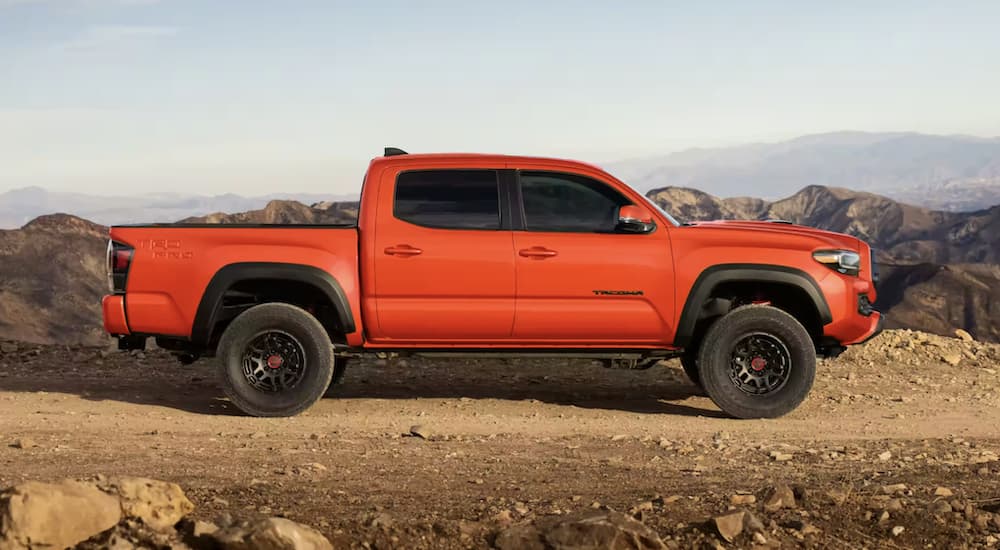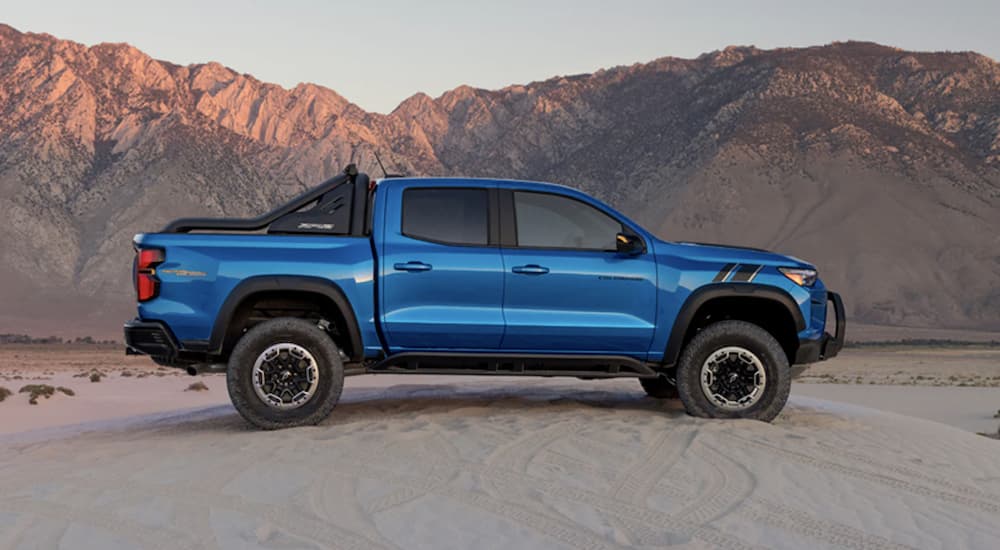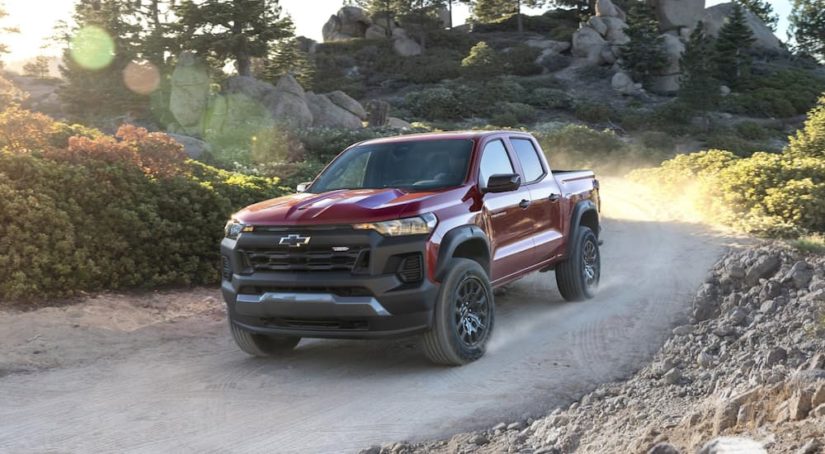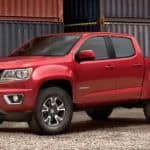In the increasingly heated battle of midsize pickups, the 2023 Chevy Colorado has a major advantage over the rest of its midsize rivals. Chevy has completely redesigned its popular midsize pickup going into its third generation, building on everything we already loved about the Colorado while addressing those areas in which it was lacking. The result is a mature, refined ride that’s come a long way since the first generation Colorado debuted back in 2004.
From a larger body to new powertrain options and a cutting-edge interior, the 2023 Chevy Colorado shows the potential to quickly separate itself from the pack with a thoroughly modern design that has the rest of the midsize segment struggling to keep up. Of course, that’s not going to keep them from trying, with perennial favorites like the best-selling Toyota Tacoma making a strong case with its 2023 model. How do the two class-leading pickups stack up in terms of power, tech, and design? Let’s take a closer look and see how the 2023 Chevy Colorado vs 2023 Toyota Tacoma shakes out.
Full-Size Power in a Midsize Truck
At first glance, it might seem like the 2023 Tacoma has the advantage over the Colorado when it comes to what’s under the hood. After all, Toyota’s midsize pickup is offered with two distinct engine options––a 2.7-liter four-cylinder and a 3.5-liter V6––while the Colorado has one engine shared amongst its five trims. That’s a little misleading, though, as the Colorado’s versatile turbocharged 2.7-liter inline-four engine has been tuned to offer different power outputs across the various models.
For example, the 2.7-liter Turbo on the base WT and LT trims produces 237 hp and 259 lb-ft of torque, while the specially tuned Turbo Plus version found in the Z71 and Trail Boss trims up the power to a considerable 310 hp and 390 lb-ft of torque. The 2.7-liter engine’s range is even more impressive when looking at the Turbo High-Output version in the top-of-the-line ZR2 model, which has 310 hp and 430 lb-ft of torque and is the perfect complement to the off-road-ready trim. This is the same engine found in the full-size Chevy Silverado 1500, giving the Colorado a major leg up over its midsize rivals. The one-engine, three-ways model is a rather ingenious approach from Chevy, which, by using the same base engine across all five trims, can keep production and repair costs down while still offering the range of performance options that drivers look for in the pickup segment.
Despite offering twice as many engine options, the Tacoma lags behind the Colorado in terms of pure power. The difference is most noticeable in the pickups’ base engines, with the Tacoma’s own 2.7-liter four-cylinder offering looking relatively anemic at 159 hp and 180 lb-ft of torque. The optional 3.5-liter V6 does improve things somewhat with an output of 278 hp and 265 lb-ft of torque, but it’s still less powerful than the Colorado’s two upper engine options. Unlike the Colorado, the Tacoma does offer a six-speed manual transmission in addition to a six-speed automatic, but the latter is a bit underwhelming, struggling to work in tandem with the Toyota’s less powerful engine and delivering a bit of a sluggish ride as a result. The Toyota also has a lower towing capacity than the Chevy, with a maxed-out Colorado boasting 7,700 lbs to the Tacoma’s 6,800 lbs.

The Latest Tech Features
Technology has become increasingly important to the driving public, even in the historically working-class midsize pickup segment. Given how thoroughly technology has managed to invade every aspect of our lives, this comes as little surprise. However, it’s still nice to see automakers responding to the trend and working to continually update their models. Driver-assistance features and infotainment tech have come a long way since the basic cruise control and AM/FM radios of the past, though some brands seem to take the task more seriously than others.
Chevy certainly knows how to hold its own when it comes to keeping up in the technological arms race, and the 2023 Colorado is a perfect example. The new third-generation model features a segment-leading 11.3-inch infotainment touchscreen and 8.0-inch digital gauge cluster as standard equipment, allowing drivers to enjoy the latest in on-the-go entertainment, navigation, and safety tech without having to put up with a cramped display. Interaction is made even easier through the inclusion of Google Built-In, which allows drivers to use voice activation and customize infotainment functions by linking the vehicle with their Google account. Chevy’s midsize pickup rounds out its tech credentials with the now-expected slate of connectivity features like Android Auto and Apple Carplay and novel features like wireless charging.
In comparison to the Colorado, the 2023 Toyota Tacoma struggles to keep pace on the tech side of the equation. This is somewhat excusable as Toyota’s offering is now in the eighth year of its third generation, but given the increasing importance of tech in the segment, our patience is beginning to wear thin. Toyota did give the Tacoma a facelift in 2020 that saw the addition of Apple CarPlay, Android Auto, and Amazon Alexa capability, but it’s a classic case of too little, too late, especially when one starts to examine the pickups’ undersized displays.
The base model Tacoma’s infotainment touchscreen is only seven inches on the base model, with a paltry upgrade to eight inches on all other trims. We know that bigger isn’t always better, but when you’re talking about a screen that you’ll be interacting with while moving at highway speeds or navigating dense traffic, we’d prefer something a little larger. The Tacoma does get points for its available wireless charging, but it lacks a mobile hotspot, and the infotainment system’s user interface is starting to seem a little dated as we work our way through the 2020s.
Designed to Work
When you only update your models every decade or so, it’s important to get it right. Chevy seems to have taken the task seriously with the 2023 Colorado, starting from scratch to bring the pickup’s interior firmly into the modern day. The pickup––which is sold exclusively as a four-door crew cab––is extremely spacious, with a comfortable, stylish interior that elevates the Colorado well above some of its more rough-and-tumble competitors.
The most noticeable improvement comes in terms of the materials used throughout the interior, which impart a more stylish, mature look than its second-generation predecessor. In addition to the massively upgraded infotainment display and digital gauge cluster mentioned above, the Colorado also gains a new steering wheel and a relocated center console that addresses some of the ergonomic concerns we had with the last model. The 2023 model also offers an optional sunroof––a new feature for the Colorado––injecting some natural light into the cabin and making for a more airy experience overall.
Despite the 2020 facelift, the Tacoma’s age is definitely starting to show when it comes to the interior. The minimalist, no-nonsense approach might have worked well back in 2016 when the second-generation model first hit the market, but the bar has been raised by a considerable margin in the intervening years. This is even the case on the Tacoma’s higher trim levels where––despite the price creeping into the high $40,000 range––the basic, utilitarian design approach still holds strong. We’re sure this will be at the top of Toyota’s list for issues to address going into the long-awaited fourth generation, but for now, it puts the Tacoma at a major disadvantage over well-equipped models like the Colorado.
When it comes to the pickup’s bed, both the Colorado and Tacoma are packed with fun little features that go a long way in improving the utility of the two pickups. The Chevy model has cupholders and a measuring tape molded into the tailgate, as well as eight tie-downs (with room for an additional nine), a 110-volt power outlet, and molded grooves in the front bed wall that provide secure storage for bikes and motorcycles. The Colorado also has a lockable 45-inch-wide tailgate storage compartment that, in addition to storing tools and other valuables, can be loaded with ice and used as a cooler, thanks to its watertight design.
The Tacoma holds its own when it comes to in-bed features. While its deck rail system is limited to four tie-downs, it does feature a more powerful 120-volt outlet and an available insulated storage cubby similar to the Colorado (although Toyota’s option eats into bed space). The bed’s Sheet-Molded Composite (SMC) bed surface is built with durability in mind, allowing drivers to load up their pickup without having to worry about any long-term damage.

Will the Tacoma Be Dethroned?
If early reviews are any indication, 2023 could be the year that the Chevy Colorado ends the Tacoma’s run as the country’s best-selling midsize pickup. The Chevy model has all the advantages when it comes to power, tech, and interior design, giving it the edge over Toyota’s increasingly outdated model. In many ways, the comparison is a bit unfair: having not updated the Tacoma since 2016, Toyota seems to be banking on the pickup’s best-selling reputation and reliability rather than rushing out a new model.
However, eight years is a long time, and while the industry hasn’t exactly reinvented the wheel over the last decade, it has made some serious leaps and bounds, especially on the technological end. The 2023 Colorado integrates many of these new and emerging tech features and has done an admirable job of recognizing where to focus its energy while leaving some of the flash-in-the-pan trends behind. Overall it is another strong showing from these two class-leading pickups, though we certainly know which model we’d choose.



